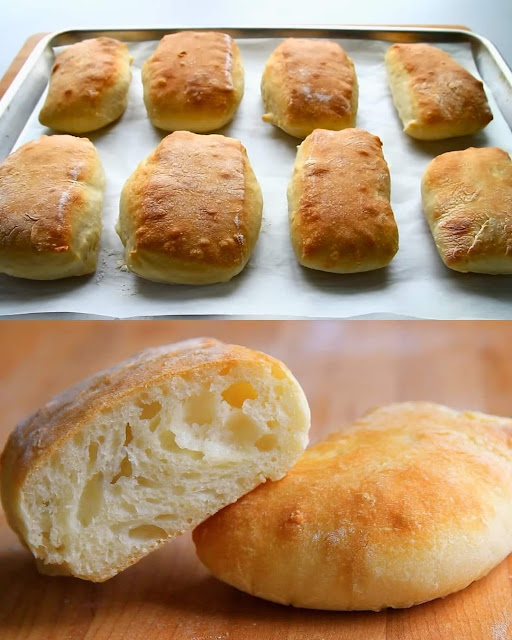Step-by-Step Instructions
Step 1: Prepare the Dough
- In a large mixing bowl, combine the flour, salt, sugar, and instant yeast. Mix well to distribute the dry ingredients evenly.
- Gradually add the warm water and olive oil to the dry ingredients, stirring with a wooden spoon or spatula until a sticky dough forms.
- Tip: The dough should be wet and shaggy—this is what gives ciabatta its airy texture.
Step 2: Knead and Rest
- Transfer the sticky dough to a clean, lightly oiled surface. Knead the dough for about 8-10 minutes, stretching and folding it repeatedly. Alternatively, you can use a stand mixer with a dough hook on medium speed for about 6-8 minutes.
- Place the kneaded dough in a lightly oiled bowl and cover it with plastic wrap or a clean kitchen towel. Let it rise in a warm place for 1-2 hours, or until it doubles in size.
Step 3: Stretch and Fold
- Once the dough has risen, lightly flour your work surface. Turn the dough out and gently stretch it into a rectangle. Fold it into thirds, like a letter.
- Return the dough to the bowl, cover it, and let it rest for another 30 minutes. Repeat this stretch-and-fold process twice more at 30-minute intervals.
Step 4: Shape the Loaves
- After the final rest, transfer the dough to a floured surface and divide it into 2-3 equal portions. Gently shape each portion into a rustic, oblong loaf. Be careful not to deflate the dough too much.
- Place the loaves on a baking sheet lined with parchment paper and dusted with semolina or flour. Cover them with a kitchen towel and let them rise for 45-60 minutes.
Step 5: Preheat the Oven
- Preheat your oven to 450°F (230°C). Place a baking stone or inverted baking sheet inside to heat up. Place a shallow pan of water on the lower rack to create steam, which helps achieve a crispy crust.
Step 6: Bake the Ciabatta
- Carefully slide the risen loaves onto the hot baking stone or baking sheet. Bake for 20-25 minutes, or until the loaves are golden brown with a hollow sound when tapped.
- Remove the bread from the oven and let it cool on a wire rack for at least 15 minutes before slicing.
Tips for Success
- High Hydration Dough: Ciabatta dough is very wet and sticky—don’t be tempted to add more flour. The high hydration is key to its airy texture.
- Stretch and Fold: This technique strengthens the dough without overworking it, creating the open crumb structure.
- Steam in the Oven: Adding steam during baking helps create the rustic, crackly crust ciabatta is known for.
- Use a Baking Stone: A hot stone or baking steel helps mimic the conditions of a professional oven, giving the bread an excellent rise and crust.
- Patience is Key: The slow fermentation and resting periods develop flavor and texture, so don’t rush the process.
Why You’ll Love This Recipe
- Simple Ingredients: With just flour, water, yeast, and a touch of olive oil, this recipe showcases how basic pantry staples can create something magical.
- Versatile Use: Ciabatta is perfect for sandwiches, dipping in olive oil and balsamic vinegar, or as a base for bruschetta.
- Rustic Charm: Its irregular shape and artisan look add a homemade touch to your table.
Serving Suggestions
Pair this ciabatta bread with a hearty soup like minestrone or creamy tomato bisque. It’s also an excellent base for paninis, avocado toast, or served alongside pasta dishes like spaghetti Bolognese or fettuccine Alfredo.






